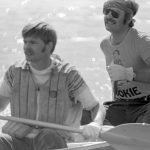Sept. 30, 1979, about 1:45 p.m.: SNAP!! @#@#@#@!!! Gerd Hartner, in the bow of his canoe at the race starting position, dipped his paddle in the water, gave a mighty first pull and, to his astonishment, broke it in half. Hilarity ensued among the cheering onlookers. Recovering quickly from the shock, Gerd was handed a replacement paddle so he and teammate David MacFarlane in the stern could start again.
This was one of the more bizarre happenings at the once-upon-a-time annual Fermilab Canoe Race around the cooling ponds of the 4-mile Main Ring particle accelerator. The race was one of the most exciting extracurricular competitions in the history of physics labs and was held on a weekend in early autumn for a few years starting in 1974. The event was founded and organized by Larry Allen, an operations specialist, with help from other employees and the Amateur Radio Club (egad, the dark ages before cell phones) for communications around the ring to monitor mishaps. The race was a time trial, with each of about a dozen canoes setting off at three minute intervals. Crowds (not large!) of spectators showed up, pizza and beer were provided afterwards, and trophies were presented to the winners.
It was a grueling experience. Paddling flat out for about an hour is hard enough, but the course is interrupted by 17 exhausting portages up and around the dikes through long prairie grass and much soft mud. Competitors included university and lab physicists, graduate students, engineers and other staff members, both men and women. Some had more enthusiasm than expertise — in one race I passed a team going the wrong way desperately trying to turn their canoe back to the right direction. Often people got soaked and muddied along the way and plunged into the water after the finish line to clean up and cool off.
The 1976 record was finally broken in 1980 by the powerful team of Steve Conlan and David Carlson in a racing canoe with professional paddles. They clocked “an astonishing time of 41:17.” As far as I can tell from the Fermilab archives, this was the last time the race was held. That year George paddled with B.J. Bjorken and came in sixth.
George is a legendary figure in North American wilderness canoeing circles, having paddled all of the great rivers, and most of the rest, in northern Canada over his lifetime, but that is another story (if interested, Google “George Luste canoe”). Sadly, he died of brain cancer in 2015.
The only year I beat George was in 1979 (he could not participate the other year I won). He used a racing canoe, which gave him a bit of an advantage over the rest of us in aluminum clunkers, but he handicapped himself by inviting the new director, Leon Lederman, to be his bowman. Leon got a shoe stuck in the mud on one of the portages and spent valuable time retrieving it, worried he and George might be disqualified if he came to to the finish line only half-shoed. According to FermiNews at the time, he claimed the difference between his time and mine was “statistically insignificant.” I suppose we would have to repeat the race many times over to prove him wrong!
On that note I encourage Fermilab to think about restarting this canoe racing tradition, since the Main Ring cooling pond course is unique in the world. Perhaps a separate kayak race could be included or even a paddleboard race (how about a kite-surfing race on a windy day? — that would be interesting, participants flying over portages, etc…). The canoe races were great fun and helped relieve some of the stress of carrying out the great physics mission of the laboratory.
John Martin, a former Fermilab user who collaborated on E25, E531, E516 and E691, is a professor emeritus at the University of Toronto.
For more on the Fermilab Canoe Races, see older issues of FermiNews: Oct. 10, 1974, p. 3; Oct. 2, 1975, pp. 1-2; Oct. 8, 1976, pp. 1-2; Sept. 28, 1978, p. 4; Oct. 11, 1979, p. 3; Sept. 25, 1980, p. 3.









